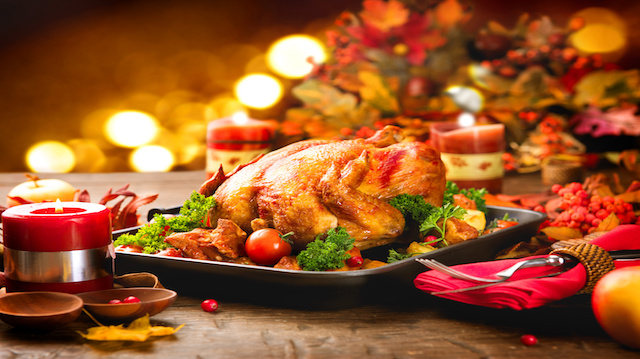
If we’re being honest, turkey is actually kind of a bland meat. Maybe once in a blue moon some inspired family member cooks it in a particularly skillful fashion for Christmas, but most years it is the same, dry, somewhat flavorless offering that remains the centerpiece of the meal as a matter of ritual.
Have you ever stopped to think that the lackluster flavor of turkey might be due to the fact that we throw away the most nutritious and flavorful parts?
That’s right, that little packet of miscellaneous bits you find inside the turkey when you buy it is actually worth its weight in gold, culinarily speaking.
Just a few generations ago, our ancestors prized the “nasty bits” — otherwise known as giblets or offal — of the turkey and of every other animal! Do you know why? It’s because these parts of the animal are packed with nutrients — much more so than the muscle meat that we focus on today!
So don’t throw the best parts to the dogs — let’s learn a little bit more about the offal of the turkey and how to make it palatable so we can take advantage of the nutritional benefits!
Decoding the offal of a turkey
Wondering what all those pieces are that you find inside your turkey? First we have the neck, which is the long slender piece. This is composed mostly of tough muscle and bones.
Then we have the liver. It is large, dark red or brown and wet-looking. Yes, we know, liver is yucky. Read on to find out how to eat this nutritional powerhouse and enjoy it!
Next there is the heart, which is quite small in a turkey (about the size of a date). Since the heart is a powerful muscle, it can be quite tough, and has a strong meaty flavor which can compliment other parts of a dish.
Lastly we have the gizzard. This lean, tough muscle sits at the top of the stomach and grinds food up, acting as a replacement for teeth! This part is also flavorful but requires special treatment since it is so tough.
Why you should eat the offal
Right about now you might be wondering why anyone in their right mind would bother eating these unfamiliar parts that require special cooking methods.
As mentioned, they can add great flavor complexity, which can take a turkey from so-so to memorable. They are also the most concentrated source of all sorts of nutrients! They are literally the original (unfashionable) superfoods.
They are super-rich in vitamins, minerals and fatty acids, which many of us lack in our modern diets. For example, liver is the best food source for B vitamins, which are vital for many health functions including energy production and mental and emotional health.
Organ meats are also loaded with minerals like phosphorus, iron, copper, magnesium, iodine, calcium, potassium, sodium, selenium, zinc and manganese, and provide the important fat-soluble vitamins A, D, E and K.
Vitamin D is rare in foods, but organ meats provide it! Kidney, liver and heart are also rich in the much-lauded super-nutrient CoQ10, which is excellent for cardiovascular health.
Try to incorporate offal into your diet not just by eating the “strange bits” of your Christmas turkey, but also throughout the year! Just make sure you seek out and invest in good-quality pastured, organic animals to get all of the good stuff and none of the bad.
How to make offal more palatable
Okay, so you’re convinced you should eat the offal because it’s so darn good for you. But how are we going to make it taste good?
 Here are some ideas to make eating the organs more appealing than appalling:
Here are some ideas to make eating the organs more appealing than appalling:
One easy technique is to simply use all of the parts to make gravy. Just boil them all together for a few hours and proceed to make the most flavorful gravy you’ve ever tasted. To take it up another notch, brown all of the pieces in butter in a pan before adding them to the pot.
If you have some fancy kitchen equipment, try grinding up all of the organ meats and use them (along with some muscle meat) to make patties, sausage or paté. This is the best way to “hide” organ meat in your meals to get the nutritional benefits without making things look or taste too weird.
Finally, try improving the flavor of liver by soaking it in milk for a few hours before cooking. This will take away the strong taste and make this highly nutritious organ more palatable.
Don’t throw away those valuable bits of the turkey — try these tips to take Christmas dinner to the next level this year! Learn more about cooking a super healthy holiday meal here!
—Liivi Hess
Liivi is an Integrative Nutrition Health Coach and is training to become a doula. She inspires women to find peace and personal power by taking control of health and fertility naturally. Liivi‘s passion is ancestral nutrition and primal lifestyle design. She and her partner Will live between Toronto, Canada and Queenstown, New Zealand.
Sources:
http://www.seriouseats.com/2012/05/offal-recipes-neck-rocky-mountain-oysters-tongue-cheeks-nasty-bits-slideshow.html#show-245232
http://www.huffingtonpost.com/2013/05/13/offal-recipes-photos_n_3254751.html
http://www.chowhound.com/post/giblets-neck-thanksgiving-573383
http://www.thepaleomom.com/2012/04/why-everyone-should-be-eating-organ.html

